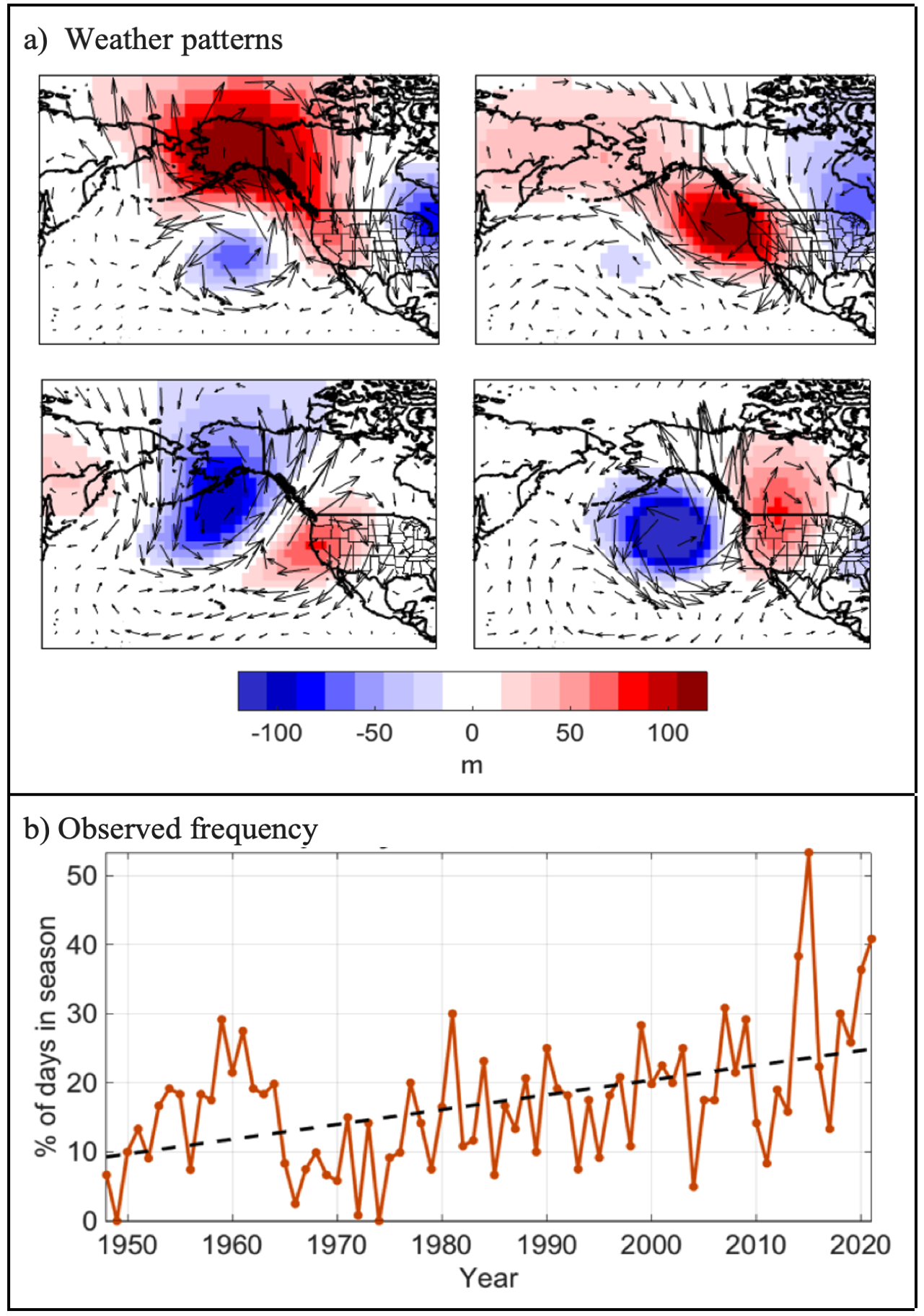
Theme 1: Atmosphere–land–ocean dynamics
Theme area 1 research will be co-led by Drs. Kristen Guirguis, Rachel Clemesha, and Sasha Gershunov and will aim to answer the broad question: How do ocean, atmosphere, and land processes drive and/or modulate extreme heat across varied coastal zone climates, and what changes are expected with climate change?
Research will be divided into three sub-topics: Coastal low cloudiness, atmospheric circulation patterns, and marine heat waves.
Coastal low cloudiness (CLC):
Low clouds modulate daytime temperatures in Southern California and add moisture to the environment. Their spatial distribution is controlled by proximity to the ocean (hence the term "marine layer"), and their presence can have a major impact on the spatial distribution of heat waves, making the ability to forecast their spatial penetration inland a matter of great value. Unfortunately, forecasting has proven difficult. It is also still unclear how CLC cover will change in the future given the complex interplay of a number of atmospheric and ocean conditions that are all themselves influenced by climate change in different ways.
Our CLC research will investigate the following questions:
- Under global warming scenarios, how do Southern California coastal low clouds vary through the 21st century? Are there any changes to seasonality? Are any of the trends that are robust across models, and consistent with meteorological and oceanic drivers, known to impact cloudiness in the historical record?
- What characterizes short lasting and long lasting CLC episodes, and how are they influenced by Pacific climate modes? What is the role of CLC in the spatio-temporal evolution of Southern California coastal heat waves, and how might it change in the future?

Coupled Model Intercomparison Project 5 (CMIP5) Global Circulation (GCM) multi-model mean projected change in monthly mean cloud albedo at the end-of-century (2070 to 2100) from historic period (1985 to 2005) using IPCC Representative Concentration Pathway (RCP) 8.5. Colors show average of nine CMIP5 GCMs where more than two-thirds of the models agree on the sign of change; white locations indicate uncertainty in future projections. Units are in % cloud albedo (cloud cover and/or brightness). Red values indicate a projected increase in cloud albedo.
Atmospheric circulation patterns:
Heat waves in Southern California can occur due to a variety of different atmospheric conditions (consider a humid, tropical heat wave vs. the dry heat associated with a Santa Ana Wind event). Much work has been conducted to understand these different processes, but questions still remain, including how they will be affected by climate change.
Our research on atmospheric circulation patterns that affect heat waves will investigate the following questions:
- What are the synoptic scale atmospheric patterns that distinguish between different flavors of heat waves in Southern California, and what is the role of persistent atmospheric weather patterns in conjunction with seasonal climate oscillations and SSTs in initiating and maintaining the most harmful heat waves?
- How will weather patterns associated with precipitation and heat waves in California change with the climate, and how will the impacts associated with these weather regimes change? How do probabilities of the most health-damaging heat waves evolve with the warming climate, particularly over Southern California’s complex landscape?
Figure caption: (a) Four weather patterns associated with winter heat waves in California shown as composites of 500-mb geopotential height anomalies, and (b) the observed combined frequency of these weather patterns over the historical record (Guirguis et al., in review).

Marine heat waves:
Heat waves do not just occur on land, but are also on the rise in the oceans as well. In recent years, marine heat waves occurring in the waters near coastal Southern California have had a large impact on wildlife and fisheries.
Our marine heat wave research will investigate the following question: How do coastal ocean temperature variations impact heat waves on land?
Improved understanding of SST variability will aid in understanding ocean drivers of both health-relevant synoptic-scale weather patterns and coastal low cloud conditions, thereby enabling extension of our methods to other locations.

